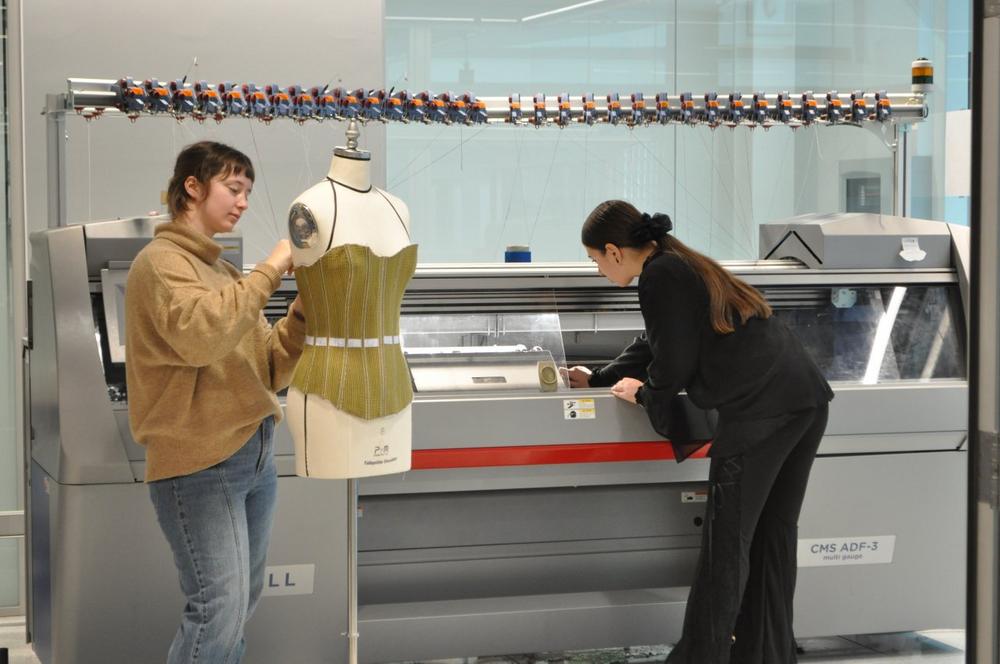More fun and efficiency in learning

Breaking News:
Kathmandu Nepal
Samstag, Nov 9, 2024

The knitting lab provides know-how about the various knitting techniques. The youngsters can also develop their own products, using four industrial knitting machines from STOLL in particular. The first machine, a member of the ADF family, went into operation in the summer of 2015, and since the spring of the following year, knitting programming know-how has also been offered with M1plus® and increasingly with CREATE PLUS. These courses are becoming increasingly popular. Today, there are already 20 programming stations in the Knit LAB. "Demand for the digital knitting classes has risen in recent years. Getting a place here is very valuable for your future career path," says Linda Ohrn-McDaniel.
The professor at the School of Fashion gave her first course in summer 2015 and enjoys using the machines made by STOLL because of their versatility. "I work in a very flexible environment. One day we are teaching fashion designers how to design sweaters and the next day we are collaborating with product designers, architects or medical researchers. With the STOLL machines, we can switch from one project to the next." Linda Ohrn-McDaniel also appreciates the opportunities CREATE PLUS offers for her teaching. She explained what these are to Wolfram Geuppert, Head of Knitwear Design Systems Development at STOLL, in an interview.
WG: How long have you been working with CREATE PLUS and why?
LO: In spring and fall 2023, we launched our first CREATE PLUS courses. In both classes, students started with M1plus® and then switched to the new software for their final project. We also ran two summer workshops with CREATE PLUS in 2022 and 2023, which were very successful.
For me, the versatility of the programming solution is important. We can already control many aspects with M1plus® and now also with CREATE PLUS. The software teaches students both knitting and programming know-how. In particular, the clear visualization of a knitted fabric and the simultaneous display of technical details by CREATE PLUS helps to understand the interrelationships.
WG: How did you find the switch from M1plus® to CREATE PLUS?
LO: It took a while to get to grips with the tools at first, although we consider programming to be more user-friendly overall. This is also evident in the courses. I have noticed that students who start directly with CREATE PLUS find it easier to understand the processes. For this reason, we are currently mainly using CREATE PLUS and only M1plus® in rare cases.
WG: Which CREATE PLUS functions do you use?
LO: We are offering our knitwear design course again in the spring and would like to be able to create virtual patterns and prototypes. Our students are already very experienced with CLO. We have therefore developed a tutorial for them on how to create a DXF file in CLO, import the pattern into CREATE PLUS and then export it back into CLO to develop the 3D view of a garment. Although we appreciate the development of the software with a focus on fashion, we deliberately do not use many of the method shortcut tools. In the short study period, we need to combine learning how to knit with learning how to program. Therefore, we want to teach the students above all about how the machine works and knowledge from the ground up. For example, we start with drawing shapes and pointelles in a very manual way, then move on to color arrangements and, once the knowledge is in place, more efficient methods and modules are shown. While simplified tools are great for everyday life, understanding is greater this way.
WG: Thank you for the interesting insights into the training organization of the School of Fashion.
KARL MAYER Holding GmbH & Co. KG
Industriestraße 1
63179 Obertshausen
Telefon: +49 (6104) 402-0
Telefax: +49 (6104) 402-600
http://www.karlmayer.com
![]()